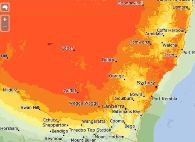Hot Friday on the way for Sydney and parts of NSW
19/11/2015

The Bureau of Meteorology is forecasting very high temperatures for parts of New South Wales Friday (20 November), with Sydney expected to reach 41°C, closing in on its November temperature record.
The heatwave conditions are caused by the combination of an approaching front and a slow-moving high pressure system over the Tasman Sea, which is drawing dry and increasingly hot air from central Australia into New South Wales.
Bureau of Meteorology NSW Severe Weather Manager Michael Logan, said temperatures were expected to soar into the low 40s across inland NSW and some coastal areas, including Sydney, on Friday.
"The forecast for Sydney has now been updated to 41°C for Friday. It’s a classic scenario of very hot and dry westerly winds with no sea breeze, followed by a blustery southerly change in the evening bringing relief," he said.
"For northeast New South Wales, heatwave conditions will continue into Saturday before the southerly change reaches these areas."
For Sydney Observatory Hill, the highest temperature on record for November is 41.8°C (25 November 1982). The highest temperature on record for all months at this location is 45.8°C (18 January 2013).
The public are urged to closely monitor the Bureau’s website for the latest weather conditions, tune into the media and local radio, and listen to the advice of emergency and health services. For life threatening situations, call Triple Zero (000).
NSW Health advises that people can help ‘Beat the Heat’ by:
- drinking plenty of water—remember to carry some with you when you’re out and about
- keeping your body and house cool
- staying out of the heat where possible—plan your day to avoid being outside after about 11am
- avoiding physical activity as much as possible.
- keeping your food safe
- visiting or phoning elderly friends, relatives or neighbours to check they are coping and find out if you can assist
- having a plan.
The Bureau’s Heatwave Service provides a measure of the build-up of 'excess' heat—a more advanced indicator than minimum and maximum temperatures alone in anticipating the impact of heat stress.










